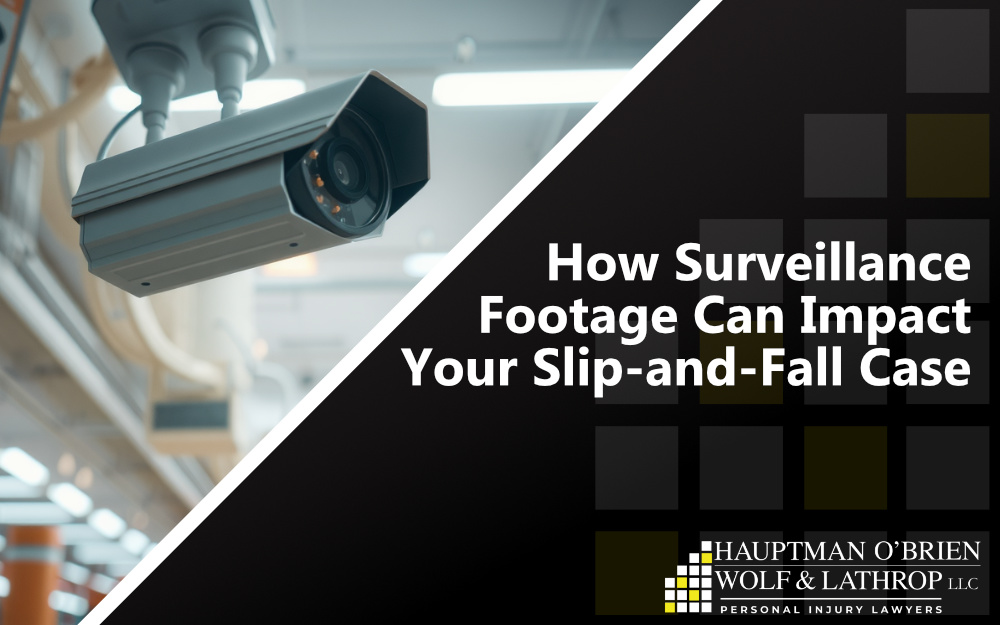
Every slip and fall case begins with a simple truth: someone fell and got hurt. But proving what happened—and why—can be a complex journey. That’s where surveillance footage often comes in. In today’s world of ever-present cameras, from grocery store aisles to office buildings, video evidence can either reinforce your claim or raise questions. At Hauptman, O’Brien, Wolf & Lathrop, LLC, our Omaha-based legal team understands the tremendous value surveillance footage plays in personal injury claims. We also know how to use such evidence strategically to seek justice and fair compensation for our clients.
Let’s look at how surveillance footage can make or break a slip and fall claim and what you should know if you’ve experienced a fall accident on someone else’s property.
The Role of Surveillance Footage for Your Slip and Fall Claim
Surveillance footage often plays a central role in building a successful slip-and-fall claim. From capturing the exact moment of the incident to illustrating the conditions that led up to it, such evidence can bring clarity and credibility to your case. Here’s how this visual record can strengthen key aspects of your claim—from proving negligence to influencing the final settlement.
Pointing Out Negligence
A slip and fall incident usually revolves around the concept of negligence when a property owner fails to maintain a safe environment. Surveillance footage showing a wet floor without a warning sign, for instance, can be crucial evidence. The lens doesn’t lie: it captures whether employees responded promptly, whether there was any attempt to clean up the hazard, and how long it remained unattended.
Such footage may also highlight recurring issues: perhaps the same puddle appears every time it rains, but no long-term solution was implemented. This visual record can illustrate patterns of neglect, not just isolated moments.
Establishing Liability
One of the hardest aspects of a personal injury case is proving liability. Who was responsible for the hazardous conditions that led to the fall accident? Surveillance cameras can help connect the dots. Was there a janitor who walked by the wet floor without addressing it? Did another customer create the spill, and did employees ignore it?
Video surveillance can cut through hearsay and provide an objective account of events. This is particularly important in environments where multiple parties may share responsibility—think shared retail spaces, large office complexes, or even parking lots monitored by third-party vendors.
Complementing Testimonies
Witness statements are vital in many slip and fall cases, but they’re also subjective. Memory can be fuzzy, and perspectives vary. Surveillance footage can complement these testimonies by offering hard, visual proof. When someone says, “She slipped near the frozen food section,” and the video footage confirms it, the case for your fall claim becomes significantly stronger.
Moreover, surveillance footage can sometimes clarify what might otherwise be a gray area. Was the lighting too dim? Was signage obscured? These subtle details often emerge clearly in security camera footage and can be decisive.
Proving Injury and Its Severity
In many slip-and-fall cases, defense attorneys may attempt to downplay the severity of the injuries or suggest they are exaggerated, or even fabricated. However, surveillance footage can provide powerful evidence to the contrary. When video captures the immediate aftermath of a fall, such as the victim crying out in pain, struggling to stand, or requiring urgent assistance, it presents a compelling, visual account that reinforces the truth of the injury. These real-time reactions often speak louder than written statements or medical reports alone.
It is also important to recognize that slip-and-fall accidents can lead to catastrophic, life-altering injuries. Victims may suffer traumatic brain injuries, spinal cord damage, broken bones, or other serious conditions that require long-term treatment and rehabilitation. Surveillance footage capturing the severity of the fall and its immediate impact helps paint a full picture of just how devastating these accidents can be.
Settlement Negotiation Impact
When it comes time to negotiate a fair settlement, strong evidence is your ally. Security footage can help personal injury lawyers build a more compelling case, giving leverage during negotiations. Insurance companies often attempt to minimize payouts, but video evidence can dismantle weak defenses.
Whether you’re claiming compensation for medical expenses, lost wages, or pain and suffering, the surveillance footage’s impact can’t be overstated. It brings undeniable weight to your claim and helps tip the scales toward fair compensation.
Types of Surveillance Footage Admissible in a Slip-and-Fall Case
Not all video recordings are created equal when it comes to supporting a slip and fall case. The source, location, and method of capture can all influence whether footage is admissible and how persuasive it will be in court. Understanding the types of surveillance footage that may apply to your case is a key step in gathering strong, reliable evidence.
Surveillance Cameras in Commercial and Public Spaces
Many slip and fall claims occur in locations with active surveillance systems, like grocery stores, malls, hotels, or office buildings. These security systems often include closed-circuit television (CCTV) cameras that record the accident scene from multiple angles.
Security camera footage from these sources is typically admissible, provided it hasn’t been tampered with. It can serve as a time-stamped, clear-cut documentation of events before, during, and after the fall.
Traffic Cameras and Public Infrastructure
In certain scenarios, traffic cameras or city-monitored surveillance systems may capture relevant angles, especially if the fall happened near building entrances, sidewalks, or public transport areas. While more difficult to obtain, this type of video footage can be incredibly telling.
Private and Residential Cameras
With the rise of smart doorbells and home security systems, footage from private residences might become relevant, especially in neighborhood or apartment complex falls. These recordings may also include surrounding walkways or shared spaces.
However, obtaining surveillance footage from private parties usually requires consent or a formal request from legal counsel. This makes the role of a fall lawyer particularly essential.
Phone Cameras and Bystander Videos
In some cases, nearby witnesses may record the slip and fall incident on their smartphones. Though less common, these videos can be powerful, especially when captured in real-time. They’re often shakier or shorter, but still valuable as supplementary evidence.
Challenges Regarding Privacy Rights
Navigating privacy rights is one of the more complex aspects of obtaining surveillance footage. Not all recordings are legally obtainable, and consent matters. For example, if the footage comes from inside a private residence or was obtained without the subject’s knowledge in a location with a reasonable expectation of privacy (like a bathroom), it may not be admissible in court.
Legal procedures vary by jurisdiction, but Nebraska courts generally uphold the admissibility of video evidence captured in public or semi-public spaces, such as store entrances, parking lots, and hallways. This makes it all the more critical to work with experienced personal injury lawyers who understand the nuances of these laws.
How to Obtain and Secure Surveillance Camera Footage
Even the most compelling surveillance footage is useless if it’s lost, overwritten, or deemed inadmissible. Preserving and securing video evidence requires urgency, precision, and legal know-how. Here’s what you need to know about safeguarding this crucial part of your slip and fall claim—and how skilled attorneys can help ensure it works in your favor.
Timing Is Everything
One of the biggest challenges in securing surveillance footage is timing. Most systems automatically delete footage after a short retention period—often as little as 48 to 72 hours. If you’ve been involved in a slip and fall accident, it’s vital to act quickly.
Ideally, you or your legal team should send a formal request to the property owner to preserve the video footage. This is often referred to as a “spoliation letter,” and it can serve as a legal notice that the footage may be relevant in an upcoming case.
Authenticity Matters
Simply obtaining the video isn’t enough—it must also be authenticated. Courts will require confirmation that the footage hasn’t been edited or manipulated in any way. Metadata, timestamps, and even the chain of custody of the footage may come under scrutiny during the legal process.
This is where the experience of your legal representation becomes invaluable. An attorney skilled in personal injury lawsuits will know how to authenticate the footage properly and ensure it holds up in court.
How Attorneys Help in This Matter
At Hauptman, O’Brien, Wolf & Lathrop, LLC, we regularly handle the complex process of obtaining and preserving video surveillance. Our legal team knows how to move swiftly, issue the proper legal notices, and coordinate with businesses, municipalities, or private parties to gather crucial evidence.
We also know how to weave such evidence into the broader narrative of your case, complementing witness statements, medical reports, and other documentation. Our goal isn’t just to get our hands on a video; it’s to use that footage effectively to prove negligence, establish liability, and secure a fair settlement.
Contact Our Slip and Fall Lawyers for a Free Consultation
If you or a loved one has suffered a slip and fall injury on someone else’s property, don’t leave your case to chance. The right surveillance footage could mean the difference between a denied claim and a successful outcome. Let our experienced legal team at Hauptman, O’Brien, Wolf & Lathrop, LLC help you pursue justice and fair compensation. We’ll review your case for free and advise you on your best path forward.
Call us today at (402) 241-5020 to schedule your free consultation, or visit our Omaha office to speak with a fall lawyer you can trust. We’re ready to help you take the next step toward recovery and resolution.


Michael Khalili represented me for a workman’s comp claim. He was amazing. Michael went over the process so I fully understood, he was in constant contact with me so I did not have to worry about how things were going. Michael was very professional and knowledgeable. I would highly recommend Michael and this firm.